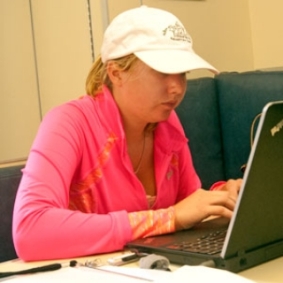Eight students will be presenting the summer work at the Ocean Sciences Meeting in March 2022!
Christine Schalkoff, Clemson University
Class Year:
2013Mentor:
Patricia Glibert, Ph.D.Project Title:
Effects of N:P Ratio Variation on Feeding of Dinoflagellate K. veneficum on Cryptophyte Rhodomonas sp.
Abstract:
Harmful Algal Blooms (HABs) are a global problem in marine and freshwater systems, leading to adverse environmental, economic, and health effects. HABs are increasing in frequency, due largely to the eutrophication of marine and freshwater ecosystems caused by increased runoff of nitrogen and phosphorus. Many HABs are formed by mixotrophic algal species, and may change their behavior based on their nutrient conditions, or the nutrient composition of their food. We experimented with one species of algae, Karlodinium veneficum that can form harmful blooms. Karlodinium veneficum and a cryptophyte food source, Rhodomonas sp., were grown separately under two different nitrogen to phosphorus ratios, and feeding crosses were done to see the effect of these different nutrient conditions on the growth and feeding of K. veneficum. The results of this experiment showed differences between K. veneficum grown at an N:P ratio of 4 and K. veneficum grown at an N:P ratio of 24 when both were fed Rhodomonas sp., as the K. veneficum grown at an N:P of 24 showed growth similar to that of the control, and K. veneficum grown at an N:P of 4 showed negative growth compared to the control. Although the results of this project were inconclusive, continued research in this area is important for collecting data on growth of harmful algal species under different nutrient conditions. These data can then be incorporated into models that attempt to successfully predict when and where HABs may occur.




